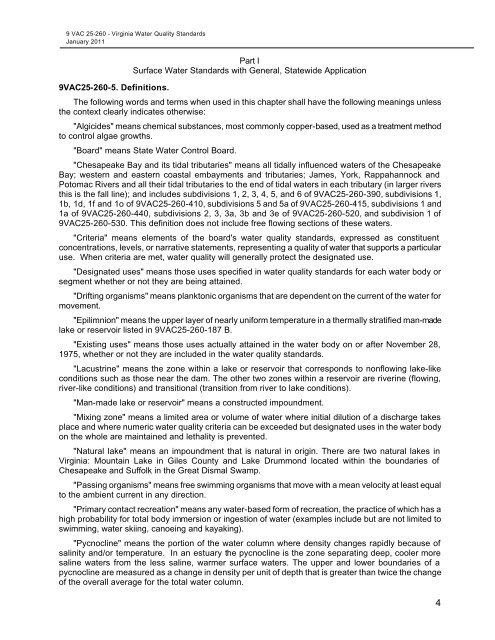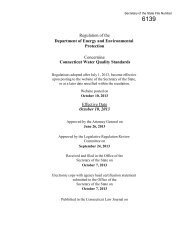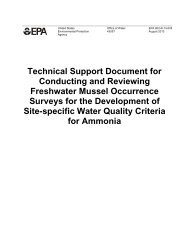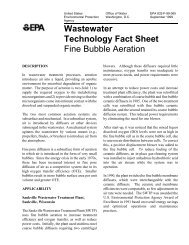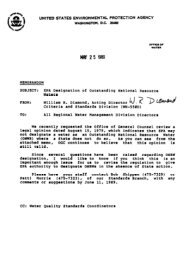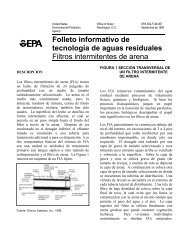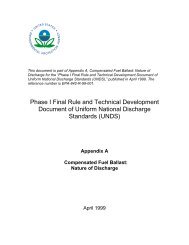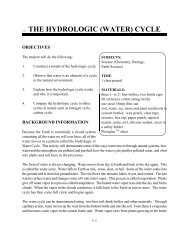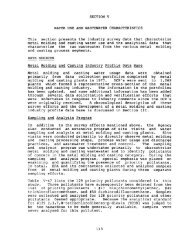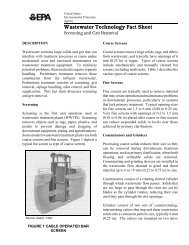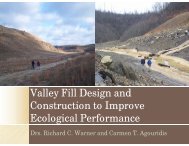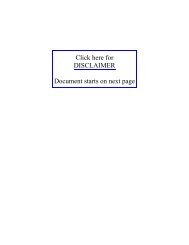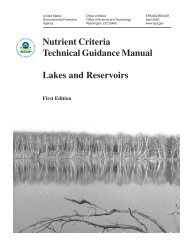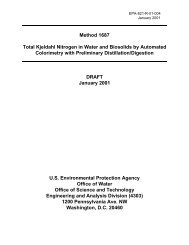Virginia Water Quality Standards - Water - US Environmental ...
Virginia Water Quality Standards - Water - US Environmental ...
Virginia Water Quality Standards - Water - US Environmental ...
Create successful ePaper yourself
Turn your PDF publications into a flip-book with our unique Google optimized e-Paper software.
9 VAC 25-260 - <strong>Virginia</strong> <strong>Water</strong> <strong>Quality</strong> <strong>Standards</strong><br />
January 2011<br />
9VAC25-260-5. Definitions.<br />
Part I<br />
Surface <strong>Water</strong> <strong>Standards</strong> with General, Statewide Application<br />
The following words and terms when used in this chapter shall have the following meanings unless<br />
the context clearly indicates otherwise:<br />
"Algicides" means chemical substances, most commonly copper-based, used as a treatment method<br />
to control algae growths.<br />
"Board" means State <strong>Water</strong> Control Board.<br />
"Chesapeake Bay and its tidal tributaries" means all tidally influenced waters of the Chesapeake<br />
Bay; western and eastern coastal embayments and tributaries; James, York, Rappahannock and<br />
Potomac Rivers and all their tidal tributaries to the end of tidal waters in each tributary (in larger rivers<br />
this is the fall line); and includes subdivisions 1, 2, 3, 4, 5, and 6 of 9VAC25-260-390, subdivisions 1,<br />
1b, 1d, 1f and 1o of 9VAC25-260-410, subdivisions 5 and 5a of 9VAC25-260-415, subdivisions 1 and<br />
1a of 9VAC25-260-440, subdivisions 2, 3, 3a, 3b and 3e of 9VAC25-260-520, and subdivision 1 of<br />
9VAC25-260-530. This definition does not include free flowing sections of these waters.<br />
"Criteria" means elements of the board's water quality standards, expressed as constituent<br />
concentrations, levels, or narrative statements, representing a quality of water that supports a particular<br />
use. When criteria are met, water quality will generally protect the designated use.<br />
"Designated uses" means those uses specified in water quality standards for each water body or<br />
segment whether or not they are being attained.<br />
"Drifting organisms" means planktonic organisms that are dependent on the current of the water for<br />
movement.<br />
"Epilimnion" means the upper layer of nearly uniform temperature in a thermally stratified man-made<br />
lake or reservoir listed in 9VAC25-260-187 B.<br />
"Existing uses" means those uses actually attained in the water body on or after November 28,<br />
1975, whether or not they are included in the water quality standards.<br />
"Lacustrine" means the zone within a lake or reservoir that corresponds to nonflowing lake-like<br />
conditions such as those near the dam. The other two zones within a reservoir are riverine (flowing,<br />
river-like conditions) and transitional (transition from river to lake conditions).<br />
"Man-made lake or reservoir" means a constructed impoundment.<br />
"Mixing zone" means a limited area or volume of water where initial dilution of a discharge takes<br />
place and where numeric water quality criteria can be exceeded but designated uses in the water body<br />
on the whole are maintained and lethality is prevented.<br />
"Natural lake" means an impoundment that is natural in origin. There are two natural lakes in<br />
<strong>Virginia</strong>: Mountain Lake in Giles County and Lake Drummond located within the boundaries of<br />
Chesapeake and Suffolk in the Great Dismal Swamp.<br />
"Passing organisms" means free swimming organisms that move with a mean velocity at least equal<br />
to the ambient current in any direction.<br />
"Primary contact recreation" means any water-based form of recreation, the practice of which has a<br />
high probability for total body immersion or ingestion of water (examples include but are not limited to<br />
swimming, water skiing, canoeing and kayaking).<br />
"Pycnocline" means the portion of the water column where density changes rapidly because of<br />
salinity and/or temperature. In an estuary the pycnocline is the zone separating deep, cooler more<br />
saline waters from the less saline, warmer surface waters. The upper and lower boundaries of a<br />
pycnocline are measured as a change in density per unit of depth that is greater than twice the change<br />
of the overall average for the total water column.<br />
4


